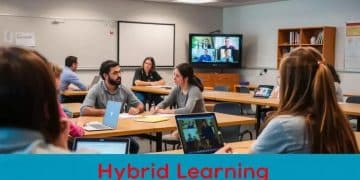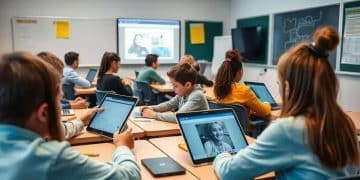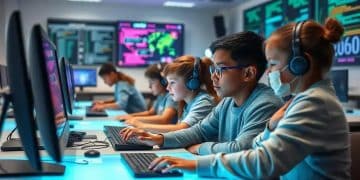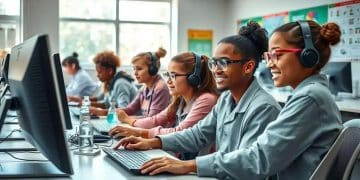Hybrid learning adoption in US universities is transforming education

Hybrid learning adoption in US universities combines in-person and online education, enhancing flexibility, personalization, and global collaboration while addressing challenges in technology access and curriculum design.
Hybrid learning adoption in US universities opens up exciting possibilities for students. Imagine a blend of in-person and online classes that gives everyone more flexibility while still fostering interactive learning. Are you ready to explore how this is reshaping education?
Understanding hybrid learning models
Understanding hybrid learning models is essential in today’s educational landscape. These models combine both in-person and online learning to create a flexible and engaging experience for students.
Key Components of Hybrid Learning
Hybrid learning integrates several key elements that enhance the educational experience. Schools and universities often create a blend of traditional classroom settings and digital tools to support learning.
- Flexibility: Students can choose their preferred learning environment.
- Engagement: Interactive tools keep students interested and involved.
- Accessibility: Learning materials are available anytime, anywhere.
- Personalization: Each student can learn at their own pace.
Moreover, hybrid learning models can vary greatly. Some institutions may implement a flipped classroom approach, where students learn new content at home and then engage in hands-on activities in class. Others might adopt a mix of synchronous and asynchronous sessions to accommodate different learning styles.
The Role of Technology
Technology plays a pivotal role in making hybrid learning successful. Platforms that facilitate video conferencing, such as Zoom or Microsoft Teams, allow for real-time interactions between students and instructors. Furthermore, learning management systems (LMS) like Canvas or Blackboard help streamline educational content and resources.
In addition, virtual reality (VR) and augmented reality (AR) are emerging tools that can enhance hybrid learning. These technologies create immersive environments that can simulate real-life situations, allowing students to apply theoretical knowledge practically.
By understanding the various hybrid learning models available, educators can tailor their teaching strategies to meet the diverse needs of their students. This awareness not only enriches the learning experience but also prepares students for future challenges in an increasingly digital world.
Benefits for students and educators

The benefits for students and educators in a hybrid learning environment are significant. This innovative approach enhances learning while also making teaching more effective and rewarding.
Benefits for Students
Students gain numerous advantages from hybrid learning models. The flexibility to choose their learning environment allows them to create a routine that suits their lifestyle. They also have increased opportunities to engage with the material. This flexibility helps students balance their studies with other responsibilities.
- Personalized learning: Each student can learn at their own pace, focusing on areas that need improvement.
- Variety of resources: Access to diverse materials and tools enhances the learning experience.
- Improved collaboration: Students can work together in person or online, fostering teamwork and communication skills.
- Increased motivation: A blended approach keeps lessons fresh and exciting.
Furthermore, hybrid learning can help students develop essential skills, such as time management and self-discipline. The need to navigate both online and offline resources encourages responsibility and independence.
Benefits for Educators
For educators, hybrid learning offers an array of benefits. It provides the chance to reach a wider audience and engage with students in innovative ways. Teachers can adapt lessons to incorporate different types of media, which enriches the teaching experience.
- Enhanced teaching strategies: Educators can use various tools and platforms to cater to different learning styles.
- More efficient use of time: With online resources, instructors can assign tasks that students can complete independently.
- Professional development: Teachers can explore new technologies, enhancing their skills and methodologies.
- Better assessment methods: Online platforms offer innovative ways to assess student understanding.
Hybrid learning not only helps students excel but also allows educators to thrive in their professions. By embracing this model, both groups can benefit from a richer, more engaging educational experience.
Challenges in implementation
Implementing hybrid learning models presents several challenges that both educators and institutions must navigate carefully. Although there are many benefits to this educational approach, there are obstacles to ensure its success.
Technology Barriers
One major challenge is the reliance on technology. Not all students have access to reliable internet or devices, which can hinder their ability to participate fully in hybrid learning.
- Device access: Students may not have personal devices to use at home.
- Connectivity issues: Wi-Fi access can be inconsistent, especially in rural areas.
- Technical support: Lack of available support can frustrate both students and teachers.
Additionally, educators themselves may struggle with using technology effectively. Professional development is essential for them to adapt to new tools and platforms.
Curriculum Design
Designing a curriculum that works well in both in-person and online settings is another considerable hurdle. Teachers must carefully plan lessons to ensure they engage students across different environments.
- Consistency: Keeping content consistent across formats can be difficult.
- Engagement: Ensuring that all students are engaged, regardless of their learning mode, is a challenge.
- Assessment methods: Finding appropriate ways to assess both in-person and remote learners takes creativity.
Moreover, educators need to be adaptable. They must be ready to shift their teaching styles based on student needs and feedback. This flexibility may be taxing, especially for those accustomed to traditional teaching methods.
Student Readiness
Another challenge involves student readiness for hybrid learning. Not every student thrives in an environment that merges online and in-person elements. It can be tough for some to manage their learning effectively.
- Self-motivation: Students must be motivated to engage with their work independently.
- Time management: Balancing online and offline studies can be overwhelming for many.
- Support systems: Students may need additional support to navigate the demands of hybrid learning.
Despite these challenges, understanding them allows educators and institutions to devise strategies to overcome them. By addressing these obstacles head-on, the potential of hybrid learning can be fully realized.
Future trends in hybrid learning

The future trends in hybrid learning are shaping the way education evolves. As technology advances, new methods and tools emerge that enhance the learning experience for both students and educators.
Increased Personalization
One exciting trend is the move toward increased personalization in hybrid learning. With the use of data analytics, educators can better understand student needs and tailor their teaching strategies accordingly. This approach allows for more customized learning paths that cater to individual strengths and weaknesses.
- Adaptive learning technologies: These systems adjust the difficulty of materials based on a student’s performance.
- Personalized learning plans: Educators can create specific goals for each student, enhancing engagement and effectiveness.
- Real-time feedback: Immediate assessments help students understand their progress and areas needing improvement.
Another trend is the integration of artificial intelligence in educational tools. AI can assist in grading, provide valuable insights into student performance, and even offer personalized study recommendations.
Global Collaboration
As hybrid learning evolves, global collaboration becomes easier. Students and teachers can connect across borders, sharing knowledge and experiences. This exposure to different cultures and ideas enriches the learning environment.
- Virtual exchange programs: Schools can create programs that pair students from different countries for collaborative projects.
- Online workshops and seminars: Access to global experts allows for diverse perspectives on various subjects.
- Shared resources: Institutions can collaborate on developing materials and best practices.
Furthermore, the demand for global skills is prompting curricula to evolve. Integrating real-world scenarios and cross-cultural communication into lessons equips students with the tools needed for success in a connected world.
Emerging Technologies
The use of emerging technologies, such as virtual reality (VR) and augmented reality (AR), is another significant trend in hybrid learning. These tools create immersive experiences that enhance understanding and retention.
- VR simulations: Students can experience historical events or scientific concepts firsthand.
- AR applications: Interactive elements can be added to textbooks, bringing subjects to life.
- Gamification: Incorporating game-like elements can boost motivation and engagement.
As these technologies become more accessible, they will likely become integral parts of the hybrid learning experience, enabling students to engage with content in dynamic ways.
FAQ – Frequently Asked Questions about hybrid learning adoption in US universities
What are the main benefits of hybrid learning for students?
Hybrid learning provides students with flexibility, personalized learning opportunities, and access to a variety of resources, enhancing their overall learning experience.
How does technology influence hybrid learning?
Technology is essential in hybrid learning as it facilitates online classes, enhances engagement with digital tools, and allows for real-time collaboration.
What challenges do educators face with hybrid learning models?
Educators may encounter challenges such as technology access issues for students, the need to design an adaptable curriculum, and the requirement for training in new tools.
What are the future trends in hybrid learning?
Future trends include increased personalization of learning, greater global collaboration among students, and the integration of emerging technologies like VR and AI into the educational experience.





